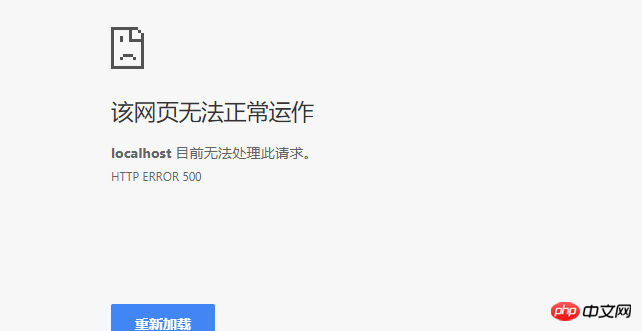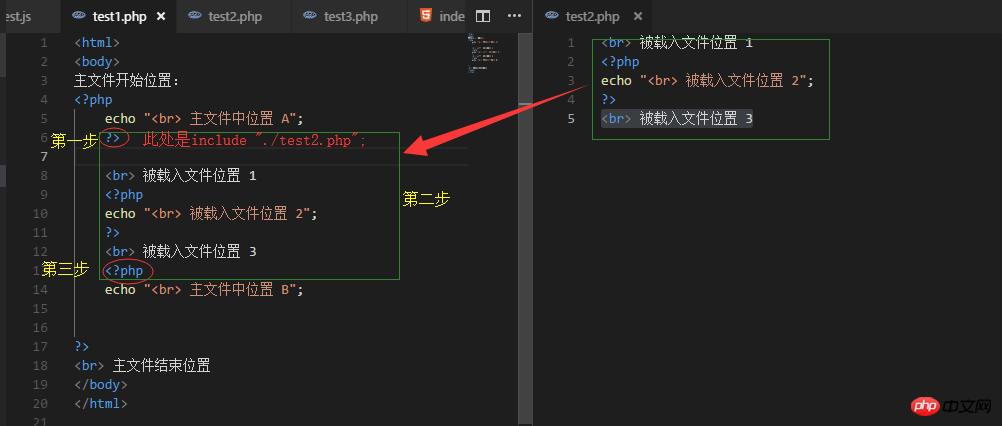PHP中引入檔案的方法有哪些? PHP引入檔案的四種方法介紹(程式碼)
PHP引入檔案的方式有哪些? PHP引入檔案有四個語句:include、require、include_once、require_once,我們來看看PHP引入檔案的具體實例。
基本語法
require:require函數一般放在PHP腳本的最前面,PHP執行前就會先讀入require指定引入的文件,包含並嘗試執行引入的腳本文件。 require的工作方式是提高PHP的執行效率,當它在同一個網頁中解釋過一次後,第二次就不會解釋。但同樣的,正因為它不會重複解釋引入文件,所以當PHP中使用循環或條件語句來引入文件時,需要用到include。
include:可以放在PHP腳本的任何位置,一般放在流程控制的處理部分。當PHP腳本執行到include指定引入的檔案時,才將它包含並嘗試執行。這種方式可以把程式執行時的流程簡單化。當第二次遇到相同檔案時,PHP還是會重新解釋一次,include相對於require的執行效率下降很多,同時在引入檔案中包含使用者自訂函數時,PHP在解釋過程中會發生函數重複定義問題。
require_once / include_once:分別與require / include作用相同,不同的是他們在執行到時會先檢查目標內容是不是在之前已經導入過,如果導入過了,那麼便不會再重複引入其同樣的內容。
相互差異
#include與require:
## include有傳回值,而require沒有回傳值 include在載入檔案失敗時,會產生一個警告(E_WARNING),在錯誤發生後腳本繼續執行。所以include用在希望繼續執行並向使用者輸出結果時。//test1.php
<?php
include './tsest.php';
echo 'this is test1';
?>
//test2.php
<?php
echo 'this is test2\n';
function test() {
echo 'this is test\n';
}
?>
//结果:
this is test1//test1.php
<?php
require './tsest.php';
echo 'this is test1';
?>
//test2.php
<?php
echo 'this is test2\n';
function test() {
echo 'this is test\n';
}
?>
include與include_once:
include載入的檔案不會判斷是否重複,只要有include語句,就會載入一次(即使可能出現重複載入)。而include_once載入檔案時會有內部判斷機制判斷前面程式碼是否已經載入過。這裡要注意的是include_once是根據前面有無引入相同路徑的文件為判斷的,而不是根據文件中的內容(即兩個待引入的文件內容相同,使用include_once還是會引入兩個)。//test1.php <?php include './test2.php'; echo 'this is test1'; include './test2.php'; ?> //test2.php <?php echo 'this is test2'; ?> //结果: this is test2this is test1this is test2 //test1.php <?php include './test2.php'; echo 'this is test1'; include_once './test2.php'; ?> //test2.php <?php echo 'this is test2'; ?> //结果: this is test2this is test1 //test1.php <?php include_once './test2.php'; echo 'this is test1'; include './test2.php'; ?> //test2.php <?php echo 'this is test2'; ?> //结果: this is test2this is test1this is test2 //test1.php <?php include_once './test2.php'; echo 'this is test1'; include_once './test2.php'; ?> //test2.php <?php echo 'this is test2'; ?> //结果: this is test2this is test1
require和require_once:同include和include_once的差別相同。
載入時執行程序
1. 從include(require)語句退出php腳本模式(進入html程式碼模式)2. 載入include語句所設定的檔案中的程式碼,並嘗試執行3. 退出html模式,重新進入php腳本模式,繼續後面腳本程式的執行
//test1.php
<html>
<body>
主文件开始位置:
<?php
echo "<br> 主文件中位置 A";
include "./test2.php"; //要载入的文件
echo "<br> 主文件中位置 B";
?>
<br> 主文件结束位置
</body>
</html>
//test2.php
<br> 被载入文件位置 1
<?php
echo "<br> 被载入文件位置 2";
?>
<br> 被载入文件位置 3

#載入時的路徑問題
相對路徑:
相對於目前網頁檔案所在位置來定位某個被載入的檔案位置。./ 表示表示当前位置,即当前网页文件所在的目录 . . / 表示上一级位置,即当前网页文件所在目录的上一级目录 //例如: include "./test2.php"; require "../../test3.html";
絕對路徑:
分為本機絕對路徑與網路絕對路徑本地絕對路徑:
從本地的根目錄逐層遞歸向下找,直到找到對應目錄下的待引入檔案。include "C:/PHP/test/test2.php";
<?php define('DS') or define('DS',DIRECTORY_SEPARATOR); echo "使用绝对路径引入(方法一)"; include __DIR__ . DS . 'test2.php'; echo "使用绝对路径载入方法(方法二)"; $root = $_SERVER['DOCUMENT_ROOT']; // 获得当前站点的根目录 include $root.DS.'node_test'.DS.'inAndRe'.DS. 'test2.php'; ?>
網路絕對路徑:
透過網址連結到檔案下,伺服器會將網址指向的檔案執行後回傳回來include "http://www.lishnli/index.php"
無路徑:
只給檔名而沒有給予路徑訊息,此時PHP會在目前網頁目錄下找該文件,如果找到相同名字的文件,執行並引入。需要注意:无论采用哪种路径,必须要加上文件后缀名,这四种文件载入方式不能识别无后缀的文件。
//test1.php include "./test2.php"; //结果:this is test2 //test1.php include "./test2"; //结果:
返回值的比较
上文说道include有返回值,而require无返回值
对于include,如果载入成功,有返回值,返回值为1;如果载入失败,则返回false.
对于require,如果载入成功,有返回值,返回值为1;如果载入失败,无返回值。
//test1.php <?php $a = include "./test2.php"; var_dump($a); echo "<br>"; $b = include "./test2.phps"; var_dump($b); echo "<br>"; $c = require "./test2.php"; var_dump($c); echo "<br>"; $d = require "./test2.phps"; var_dump($d); ?>
输出:

当文件中有return:
当被载入文件中有return语句时,会有另外的机制,此时return语句的作用是终止载入过程,即被载入文件中return语句的后续代码不再载入。return语句也可以用于被载入文件载入时返回一个数据。
//test1.php <?php $a = include "./test2.php"; echo "<br>"; var_dump($a); ?> //test2.php //该文件中有return语句 <?php $b = 'test2'; echo "被载入的文件:A 位置"; return $b; echo "<br 被载入的文件: B 位置"; ?>
结果:

相关推荐:
php 字符串写入文件或追加入文件(file_put_contents)
以上是PHP中引入檔案的方法有哪些? PHP引入檔案的四種方法介紹(程式碼)的詳細內容。更多資訊請關注PHP中文網其他相關文章!

熱AI工具

Undresser.AI Undress
人工智慧驅動的應用程序,用於創建逼真的裸體照片

AI Clothes Remover
用於從照片中去除衣服的線上人工智慧工具。

Undress AI Tool
免費脫衣圖片

Clothoff.io
AI脫衣器

Video Face Swap
使用我們完全免費的人工智慧換臉工具,輕鬆在任何影片中換臉!

熱門文章

熱工具

記事本++7.3.1
好用且免費的程式碼編輯器

SublimeText3漢化版
中文版,非常好用

禪工作室 13.0.1
強大的PHP整合開發環境

Dreamweaver CS6
視覺化網頁開發工具

SublimeText3 Mac版
神級程式碼編輯軟體(SublimeText3)
 在PHP API中說明JSON Web令牌(JWT)及其用例。
Apr 05, 2025 am 12:04 AM
在PHP API中說明JSON Web令牌(JWT)及其用例。
Apr 05, 2025 am 12:04 AM
JWT是一種基於JSON的開放標準,用於在各方之間安全地傳輸信息,主要用於身份驗證和信息交換。 1.JWT由Header、Payload和Signature三部分組成。 2.JWT的工作原理包括生成JWT、驗證JWT和解析Payload三個步驟。 3.在PHP中使用JWT進行身份驗證時,可以生成和驗證JWT,並在高級用法中包含用戶角色和權限信息。 4.常見錯誤包括簽名驗證失敗、令牌過期和Payload過大,調試技巧包括使用調試工具和日誌記錄。 5.性能優化和最佳實踐包括使用合適的簽名算法、合理設置有效期、
 會話如何劫持工作,如何在PHP中減輕它?
Apr 06, 2025 am 12:02 AM
會話如何劫持工作,如何在PHP中減輕它?
Apr 06, 2025 am 12:02 AM
會話劫持可以通過以下步驟實現:1.獲取會話ID,2.使用會話ID,3.保持會話活躍。在PHP中防範會話劫持的方法包括:1.使用session_regenerate_id()函數重新生成會話ID,2.通過數據庫存儲會話數據,3.確保所有會話數據通過HTTPS傳輸。
 PHP 8.1中的枚舉(枚舉)是什麼?
Apr 03, 2025 am 12:05 AM
PHP 8.1中的枚舉(枚舉)是什麼?
Apr 03, 2025 am 12:05 AM
PHP8.1中的枚舉功能通過定義命名常量增強了代碼的清晰度和類型安全性。 1)枚舉可以是整數、字符串或對象,提高了代碼可讀性和類型安全性。 2)枚舉基於類,支持面向對象特性,如遍歷和反射。 3)枚舉可用於比較和賦值,確保類型安全。 4)枚舉支持添加方法,實現複雜邏輯。 5)嚴格類型檢查和錯誤處理可避免常見錯誤。 6)枚舉減少魔法值,提升可維護性,但需注意性能優化。
 描述紮實的原則及其如何應用於PHP的開發。
Apr 03, 2025 am 12:04 AM
描述紮實的原則及其如何應用於PHP的開發。
Apr 03, 2025 am 12:04 AM
SOLID原則在PHP開發中的應用包括:1.單一職責原則(SRP):每個類只負責一個功能。 2.開閉原則(OCP):通過擴展而非修改實現變化。 3.里氏替換原則(LSP):子類可替換基類而不影響程序正確性。 4.接口隔離原則(ISP):使用細粒度接口避免依賴不使用的方法。 5.依賴倒置原則(DIP):高低層次模塊都依賴於抽象,通過依賴注入實現。
 在PHPStorm中如何進行CLI模式的調試?
Apr 01, 2025 pm 02:57 PM
在PHPStorm中如何進行CLI模式的調試?
Apr 01, 2025 pm 02:57 PM
在PHPStorm中如何進行CLI模式的調試?在使用PHPStorm進行開發時,有時我們需要在命令行界面(CLI)模式下調試PHP�...
 如何在系統重啟後自動設置unixsocket的權限?
Mar 31, 2025 pm 11:54 PM
如何在系統重啟後自動設置unixsocket的權限?
Mar 31, 2025 pm 11:54 PM
如何在系統重啟後自動設置unixsocket的權限每次系統重啟後,我們都需要執行以下命令來修改unixsocket的權限:sudo...
 如何用PHP的cURL庫發送包含JSON數據的POST請求?
Apr 01, 2025 pm 03:12 PM
如何用PHP的cURL庫發送包含JSON數據的POST請求?
Apr 01, 2025 pm 03:12 PM
使用PHP的cURL庫發送JSON數據在PHP開發中,經常需要與外部API進行交互,其中一種常見的方式是使用cURL庫發送POST�...







